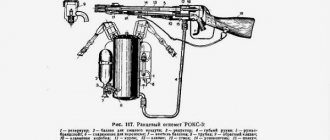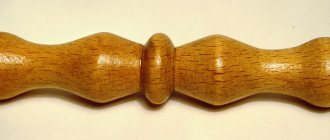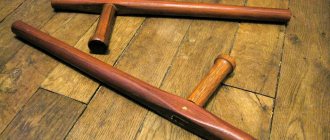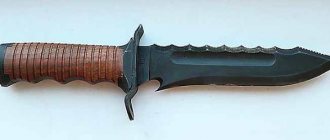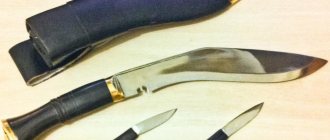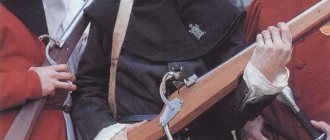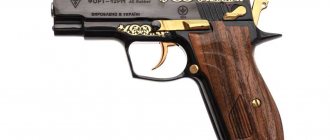Quite often on the shelves of museums in the exhibition of ancient weapons you can find very unusual objects - sticks with a metal chain, at the end of which there is a heavy metal ball. This is a flail. The device may differ in design, size and equipment, but in any form its impressive appearance is preserved. At first glance, it is difficult to imagine how such a weapon should have been handled and for what purposes it was used. However, the imagination quite colorfully depicts the consequences of using such bladed weapons in battle. It is not difficult to imagine what terrible wounds a heavy metal weight dangling from a chain, equipped with sharp spikes, could inflict on an enemy.
Knight and flail
Where did such bladed weapons come from?
Judging by its shape, the flail is clearly intended for horse fighting. This is due to the lightness of the weapon and its great mobility. A horseman who skillfully handled such weapons and mastered the techniques of equestrian combat could freely deliver a sudden, devastating blow to the enemy. The force of the backhand strike was so strong that the opponent could easily be knocked out of the saddle. If the blow fell casually, then the rider who remained in the saddle would be stunned for some time. Only a shield could save him from a crushing blow from a metal weight. The steel armor of warriors rarely provided reliable protection from a deafening blow from a heavy weight during a combat clash. The large kinetic energy during the swing, multiplied by the weight of the weapon, provided enormous force to the blow. The only argument that could be opposed to such cold weapons was striking first.
It should be noted that during the battle, the flail was rarely used. Rather, it was an auxiliary weapon that warriors used when it was impossible to use the main types of weapons. If a spear or pike was lost, or a sword was lost, such a bladed weapon as a flail became the last powerful argument for a warrior. However, many warriors from among the nobility neglected the combat capabilities of such weapons, considering them to be the weapons of commoners.
The first information about the combat use of the flail appeared in Europe at the beginning of the 11th century. Over time, it became clear that such a device, used as a bladed weapon, is quite common in the world. Weights on a chain were used by knights of medieval England, Germany and Italy during the Crusades. Muslims also had similar weapons. The heavily armed horsemen of Salah ad-Din's army used flails in confrontation with the knights - the crusaders. In ancient Japanese drawings and frescoes you can see a flail on the equipment of samurai.
Russian warriors
In the form in which we present this weapon, it appeared much later. Originally it was a battle flail, very reminiscent of a device for threshing grain. Later, attempts were made to modernize this type of bladed weapon, making it more respectable and representative. In Rus', a similar type of weapon was used during the campaigns of the ancient Russian princes against Constantinople and in battles with the Polovtsians and Pechenegs. Old Russian warriors were equipped with proven types of these weapons and mastered special combat techniques.
Kisten is a name with Slavic roots. The meaning of this word can be interpreted differently, but the essence does not change. The weapon was put on the hand and was activated by rotating the hand. Considering the fact that the Slavs had to fight for a long time against nomadic tribes of Turkic origin, an analogy can be drawn with the Turkic name. “Kistan” translated from the Turkic language means “stick”.
Impact part
The popularity of the weapon is explained by its simple design and low cost. The prototype of the combat flail is a threshing stick, which was often used to arm the militia. Having quickly identified the fairly high effectiveness of the device in battle, they changed its shape. The stick was shortened, and a beater made from animal bones was attached to a chain. For wealthy warriors, the flail receives a metal beater. From a two-handed type, the weapon turns into a one-handed one, lighter and more flexible. Its impact-crushing effect is enhanced. In Rus', the name of the weapon was finally established, while in Europe such edged weapons are called in the German manner - morningstern.
PPSh against wire
On the eve of the new year, 1945, the headquarters of the 5th Shock Army sent out to its units a recommendation on making passages in the wire fence with machine gun fire. It turned out that the gunsmiths of the 94th division had come up with a muzzle - an attachment to the PPSh barrel - and tested it in action. The result was quite good.
The muzzle was a tube made of roofing iron, eight to nine centimeters long and 3.5–3.7 centimeters in diameter. There were holes in it on the sides for gases to escape, and in the front there were four cutouts for placing barbed wire along the axis of the bullet’s flight.
We used it as follows. The machine gunner crawled up to the thorn fence, pressed the muzzle tightly against the steel thread and fired a single shot. Having broken it in one place, he shot through the wire in other places until a passage appeared.
If the muzzle caught several threads, the fighter fired a short burst.
Several trained machine gunners could make a passage through the barrier faster than sappers with scissors.
Tactical and technical characteristics of the flail
In the usual combat version, the total length of the weapon was 45-55 cm. The flail consisted of a striking part - a beater, which could be of different designs. The stick or handle was usually made of wood. For noble warriors, it was customary to decorate the handle with various metal parts, giving the weapon a special value. The handle could be covered with leather for a comfortable grip. At the end there was a leather loop through which the hand was fixed to the wrist.
Iron beater
In medieval Europe, where there were better technical conditions for the manufacture of metal bladed weapons, various models of flails appeared. The knights preferred to have a morning star, which had a metal beater with steel spikes. A blow to steel armor with such an object could be fatal to the enemy. The spikes easily pierced armor and helmets. Among the warriors who owned these weapons, they adhered to the following principle - one blow - one death.
The German morning star or flail, which began to appear in the arsenal of private feudal armies, was made quite primitively and crudely. Only with the beginning of the Crusades, when an unspoken competition arose between noble knights in the quality of combat equipment, more noble examples of these weapons appeared. The handle was initially missing. The chain with the weight was simply put on a wooden stick if necessary. In some versions, at the end of the chain there was a special hook - a bracket on which some kind of load could be fixed as a beater.
The noble cavalry, which preferred to show off in front of each other, introduced its own innovations to combat equipment. Weapons become more sophisticated. Particular emphasis is placed on the appearance of the weapon. The flail handles take on a more convenient shape for gripping, with a square or oval cross-section. For a warrior in the thick of hand-to-hand combat, it was important not to let go of the weapon at a crucial moment. For more effective use of edged weapons in combat, the weight standards of the striking part begin to be taken into account during manufacturing.
For example: A lead beater the size of a walnut and weighing 200-300 g when hit during a backswing produced a force of 16 kg per cm2. One can only imagine what the warrior felt when receiving such a blow.
It is not advisable to make a larger weight. More weight entails more effort. The inertia of a heavy beat created during a swing can only harm the warrior himself. In addition, a brush with a large weight was inconvenient in battle. There might not have been time for a full swing. The greatest effect was produced by short and sharp wrist blows.
Flail Mastery
Destroy, cut, explode
It is logical to assume that the wire can be destroyed with cannons and mortars. But shelling the barriers did not always produce results - we had to resort to other methods.
The simplest of them is to throw improvised means (overcoats, boards, doors, straw mats, etc.) onto the wire during an attack or pull it apart using “crampons.” But under fire, both are very difficult, so it is better to cut passages in the barrage with scissors before attacking.
According to the Red Army engineering troops, the infantry had to cut the wire themselves.
According to the instructions, a rifle platoon required one passage of eight to ten meters. The platoon commander sent four to six soldiers with scissors to cut the “thorns.” This should have been done the night before the attack or during artillery preparation. Sappers were involved only in special cases - if an obstacle needed to be undermined.
But in practice everything looked different.
During battles, barriers were overcome only with the participation of sappers. Without their help, the untrained infantry could not do anything on their own.
Sometimes they were helped by signalmen.
On the Nikopol bridgehead, during a night attack, signalmen followed the sappers cutting the wire, pulling the cable. Then, holding onto it with their hands, the infantry rushed in single file into the passage made.
But the Red Army found a way for riflemen to pass barbed wire on their own. Front-line “lefties” figured out how to cut them using a machine gun.
On the same topic
Guerrilla "Kulibins" and homemade weapons of underground fighters
Like all ingenious things, it was simple.
Different types of weapons and operating principles
In a combat situation, a warrior must always adequately assess the strength and power of his weapon. Using a melee weapon inappropriately can have fatal consequences, so if the enemy has a superior weapon, a spear or a two-handed sword, the flail will be useless. It was convenient for riders to use such weapons only during an equal fight or when attacking a weaker enemy.
There is a certain typology that distinguishes this edged weapon into the following types:
- the first type is a brush equipped with an elongated, ovoid-shaped bone weight. This type can be attributed to the early period when the first facts of combat use of weapons appeared (X-XII centuries);
- the second type is a shock-crushing weapon, equipped with copper or iron spherical weights. Both smooth and faceted beats are available. In this form, the flail appears in the arsenal of warriors at the end of the 12th and beginning of the 13th centuries;
- the third type is a flail or morning star, which has clear dimensions of a beater and a handle. Spikes or protrusions appear on a lead or iron weight, enhancing the damaging effect. This weapon has already been firmly included in the arsenal of warriors since the 13th century.
It should be noted that with the appearance of warriors clad in armor on the battlefield, the bone beater loses its combat significance. Riders are equipped with bladed weapons made from metal parts. Due to the metal beater, the force and concentration of the blow increases.
Different flails
Combat techniques using weapons of this type are also being improved. Techniques are practiced in which the flail can cause maximum harm to the enemy. The first blow is the most important. Subsequent defense with this type of weapon is practically impossible. Even the presence of a hilt does not allow the warrior to successfully parry retaliatory strikes. A dangling chain with a heavy load becomes an obstacle to the stable position of the weapon in the hand. The main combat use of this weapon is its combination with a sword. A horseman who is good with both a sword and a flail can simply suppress his opponent with force. To attack, a brush is used, which allows you to strike the head and even the back of the enemy. The sword is designed for effective defense against retaliatory strikes.
However, this tactic is more suitable for knightly tournaments. In a real fight, a spear or battle ax is much more effective, not to mention swords. The flail was used extremely rarely, and it was also necessary to know how to use such a weapon.
Wire fences
During the breakthrough of the German defense, the Red Army soldiers had to face various obstacles. The enemy put up wire fences, stretched a net with two or more rows of stakes, threw a Bruno spiral of barbed or smooth wire and made “stumbling”. All these types of barriers, as a rule, were reinforced with landmines, and the gaps between the rows were mined.
The meeting with the wire clearly did not bring joy to the attacking Soviet infantry.
The enemy set up barriers taking into account the location of their firing points. The approaches to them were shot through with machine guns, so the destruction of wire obstacles before or during the attack became a priority.
Historical combat experience
In the history of wars, the flail is rarely mentioned as the main weapon. The popularization of this bladed weapon is more connected with the modern interpretation of the historical events of medieval Europe. A horseman clad in knightly armor, waving a spiked metal weight dangling from a chain, must have looked quite spectacular and impressive. In reality, such a sight was rare. It was common to see such weapons in the hands of militias and commoners.
In Russian history, mass combat use of the flail occurred during the struggle of the northwestern principalities with the Teutonic Order. The Russian militia, composed of commoners and poor nobles, were armed with spears, pikes and flails. Such weapons were used against heavily armed Teutonic knights. A blow with a flail on the helmet or on the back had a stunning effect on the riders. Suffice it to recall the victory of the Russian army on Lake Peipsi, where Russian regiments, together with the Novgorod militia, defeated the Teutonic knights.
Battle Flail
In direct clashes with German knights, Russian horsemen usually used axes and spears. In Europe, the flail was actively used on the battlefield during the European Crusades against the Czech Republic. The Hussite wars were the first domestic wars in which the main striking force was not regular troops, but the people's militia. The Hussite troops were armed with a wide variety of weapons, including flails. The weapon looked like a heavy steel flail, capable of not only knocking a rider out of the saddle, but also crushing the first ranks of the advancing enemy.
After the first military clashes with the militia, the Czech nobility began to use the flail as an auxiliary weapon. The impact part began to be made heavier and equipped with additional spikes. For better flexibility, the chain links were reduced, making the weapon more convenient for combat use.
Morning Star
The most legendary weapon of this type is the flail called the Morning Star. It was a device with a heavy core on a chain. The striking part was studded with long spikes. In parallel with this type of weapon, varieties of flails with three weights dangling from a chain appear. This approach is more related to the psychological effect. It is almost impossible to use such weapons in combat. The terrifying appearance did not correspond to the real combat power of such weapons.
What traces of the flail remain in literature and history?
The successes of the use of flails by the Hussites and German peasants during the German wars were reflected in Talhoffer’s treatise “Old Weapons and the Art of Fighting,” published in 1459.
It, along with the morning star that came into use, recommended the use of its improved version with three small balls instead of one.
Another mention can be found in the treatise of Sigismund Herberstein, which described the morals and customs of medieval Muscovy.
Flails were also mentioned as one of the types of cavalry weapons, and they were required for protection even when Grand Duke Vasily III went hunting.
It stands o - a tactical knife, the creator of which is A. M. Kisten, a master of knife fighting of our time. But this is no longer relevant to our topic.
Use in combat
Light weapons provide a surprise strike for infantrymen. For heavy cavalry riders, models with metal weights weighing 100-250 g are suitable. It is easier to defeat an enemy without armor by striking the back, head, and neck.
Flails are justified as additional weapons in the presence of a sword or spear. When using them, it is worth calculating the impact force, which is 6.6-14 kg (the frontal bones are destroyed when exposed to 8 kg). By acting quickly, you can maim an unarmored man or stun an armored knight.
Ease of use is the main advantage of the morning star. Having skills in working with a flail is the basis for a high-quality attack, since it does not reflect the blow. A warrior can only count on the factor of surprise and a sharp release, but not if the enemy has good equipment or a shield.
History of origin
It is impossible to clearly track the time of the appearance of the flail. Herodotus also pointed out in his writings that in the 6th-4th centuries BC the Scythians (they lived in the south of Eastern Europe and Asia up to Mongolia) used whips as weapons in battle. Thus, before the flail appeared, it remained to attach a bone or stone weight to the end of the whip.
It has been established for certain by historians and archaeologists that the Eastern European variants of the flail originated from its various Khazar variants. Among these nomadic tribes who lived in the lower and middle reaches of the Volga, the use of combat flails was noted in the 4th-9th centuries AD.
This weapon was very suitable for the light cavalry of the nomads and could well be used along with the saber as a first strike weapon.
Since nomads constantly attacked neighboring states, it is not surprising that the flail spread in the 10th century in Ancient Rus', which was constantly subject to raids from the south.
Residents of Rus' appreciated this first strike weapon, and soon it began to be used as an auxiliary weapon for horsemen and foot warriors. Of course, the technique of working with a flail was changed in accordance with the characteristics of the fighting of our ancient ancestors.
The appearance of these bladed weapons in Central Europe is associated not only with the raids of nomads, although there were plenty of them, but also with the migration of peoples during the Middle Ages in general. Here we should recall the resettlement of the Volga Bulgars to the territory of modern Bulgaria, and the Hungarians from the Urals to the territory of modern Hungary.
These peoples were familiar with the technique of fighting with flails, and in their new place of residence they remained faithful to their previous traditions. Given the short European distances, these weapons quickly spread, first across neighboring countries, and then throughout Europe.
Here it should be remembered that the European armies of the 10th-15th centuries had armored and invulnerable knights as their main striking force.
It is clear that neither a bone nor a stone flail can cause much damage even to a knight’s helmet, so the striking part became metal.
The pinnacle of the evolution of this weapon in Europe was the appearance of the morning star (morning star), in which the striking part was a small ball with spikes.
One should not think that such weapons were common only in Europe - since the idea of attaching a striking part to a handle on a belt or chain is very simple, various versions of these weapons appeared almost everywhere where people lived.
It is worth noting the difference between weapons created from tools of production, such as a flail. Combat flails (nunchucks), unlike flails, had a shortened flexible coupling and a longer handle and striking part, which radically changed the fighting technique.
